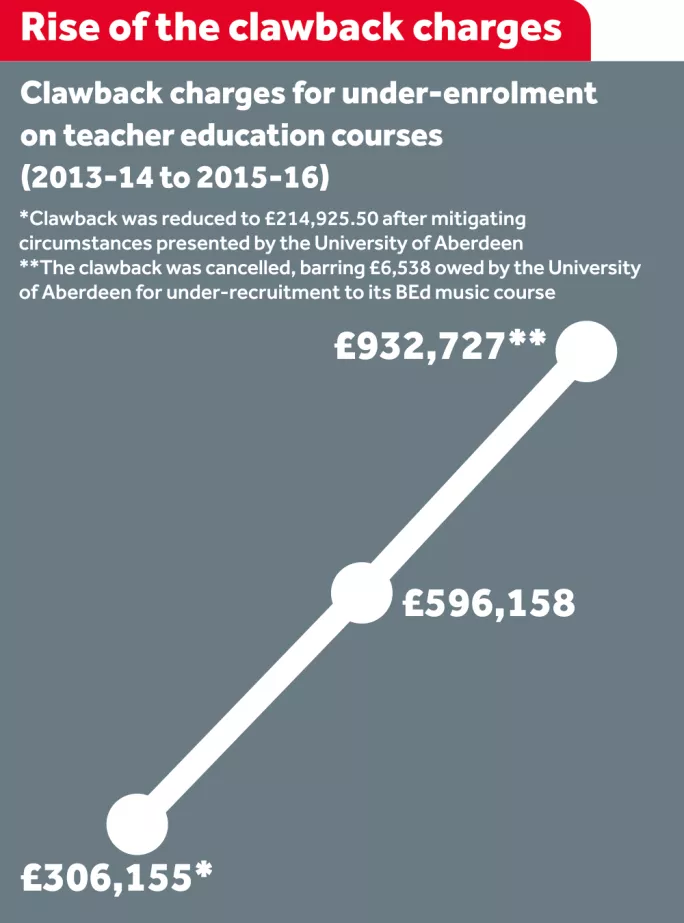Universities dodge £1m hit for under-recruitment

The Scottish government has written off nearly £1 million owed to it by schools of education for failing to fill places on secondary teacher education courses, as universities report the growth of tough-to-recruit-to subjects.
Scotland’s largest provider of initial teacher education - the University of Strathclyde - stands to save more than £500,000 and the University of Aberdeen over £200,000 after the ministers waived £926,189 of clawback charges that universities were due to pay because they had failed to fill the places that were funded in 2015-16.
However, universities are calling for the clawback system to be overhauled; figures show that the charges universities face for under-enrolment have risen exponentially in recent years, trebling between 2013-14 and 2015-16.
Now, Tes Scotland understands that universities are becoming increasingly reluctant to accept higher targets for secondary subjects that are tough to recruit to, including technological education and maths, because they could just be setting themselves up for future fines.
According to the principal and vice-chancellor of the University of Strathclyde, Professor Sir Jim McDonald, the list of secondary subjects that it is tough for universities to recruit student teachers into expanded from three in 2014-15 to eight subjects in 2015-16, including maths, physics, technological education, computing, home economics, Gaelic, modern languages and music.
He made the observation in an email sent to the Scottish Funding Council’s director of finance in March, challenging the clawback charges. The email - obtained by Tes Scotland via a freedom of information request - also revealed that if Strathclyde had been forced to pay the clawback charges for 2015-16, the viability of some secondary teacher education courses would have been threatened.
‘Not properly funded’
Universities were already having to subsidise secondary physics courses - which required specialist staff, laboratory space and equipment - because they were not being properly funded, Professor McDonald warned. He wrote: “We would highlight that the effects of a clawback on the scale experienced in the past would be to inhibit delivery, limit the number of graduates recruited and teachers educated, and compromise the viability of the current range of secondary subjects offered.”

He later added: “Delivery of a PGDE secondary physics course effectively costs the university more than the sum of the units of resource - and that’s even without the impact of any clawback.”
Clawback charges apply if the teacher education institutions over-recruit or under-recruit to their programmes. The charge per place for under-recruitment in 2015-16 was £4,738.
The current clawback model, however, does not take into account how difficult it is for the universities to recruit students to some secondary subject areas, and Professor McDonald and the Scottish Council of Deans of Education would like to see the whole model overhauled.
Professor McDonald suggested in his email to the SFC that with tough-to-recruit-to subjects like maths and physics, universities should be able to fall as much as 25 per cent below target without incurring clawback charges; the current threshold is 3 per cent.
Meanwhile, the Scottish Council of Deans of Education has suggested that universities should keep 50 per cent of the clawback for subjects that are difficult to recruit to.
Professor McDonald wrote: “The SFC should be reassured that any change in clawback as a result would be used in a targeted manner to enable us to better market our PGDE options to future applicants and to invest in our delivery and a high-quality student experience.”
Morag Redford, the chair of the Scottish Council of Deans of Education, welcomed the cancellation of the charges. However, she said that the council was now looking forward to discussing alternative models at the Teacher Workforce Planning Group. Clawback has happened at around this time every year and it has made it difficult for universities to plan, she said. “It would far better if we weren’t having to adjust on an annual basis for something that happened two years ago,” she added.
A SFC spokesman confirmed that alternative approaches to the method of clawback were set to be considered by the Teacher Workforce Planning Group
When asked if the universities were properly funded to deliver initial teacher education, he said that a new teaching funding model was introduced for 2012-13, “with prices paid for each subject being informed by information on costs of provision”. But he added that “the costs of provision is subject to ongoing review”.
A Scottish government spokesman said it had been agreed that there would be no return of funding for teacher training courses for the 2015-16 academic year, and that the government was in discussions with the Scottish Funding Council and the Scottish Council of Deans of Education on “the right approach for the future”.
You need a Tes subscription to read this article
Subscribe now to read this article and get other subscriber-only content:
- Unlimited access to all Tes magazine content
- Exclusive subscriber-only stories
- Award-winning email newsletters
Already a subscriber? Log in
You need a subscription to read this article
Subscribe now to read this article and get other subscriber-only content, including:
- Unlimited access to all Tes magazine content
- Exclusive subscriber-only stories
- Award-winning email newsletters